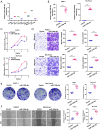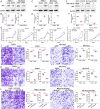Exosomal miR-125b-5p derived from cancer-associated fibroblasts promotes the growth, migration, and invasion of pancreatic cancer cells by decreasing adenomatous polyposis coli (APC) expression
- PMID: 37201069
- PMCID: PMC10186528
- DOI: 10.21037/jgo-23-198
Exosomal miR-125b-5p derived from cancer-associated fibroblasts promotes the growth, migration, and invasion of pancreatic cancer cells by decreasing adenomatous polyposis coli (APC) expression
Abstract
Background: A significant desmoplastic response, particularly in the fibroblasts, is a characteristic of pancreatic ductal adenocarcinoma (PDAC). Increasing evidence has shown that cancer-associated fibroblasts (CAFs) assist tumor development, invasion, and metastasis in PDAC. However, CAFs-derived molecular determinants that regulate the molecular mechanisms of PDAC have not been fully characterized.
Methods: The expression of microRNA 125b-5p (miR-125b-5p) in Pancreas Cancer (PC) tissue and para-cancerous normal tissue was examined using Polymerase Chain Reaction (PCR). Cell counting kit-8 (CCK8), wound healing, and transwell experiments were utilized to assess the effect of miR-125b-5p. Using a cell luciferase activity test and bioinformatics, it was demonstrated that miR-125b-5p may bind to the 3'-untranslated region (3'-UTR) of the adenomatous polyposis coli (APC), thereby limiting the progression of pancreatic cancer.
Results: PDAC cells are prompted to proliferate, undergo the epithelial-mesenchymal transition (EMT), and spread. Importantly, CAFs release exosomes into PDAC cells, which significantly increase the level of miR-125b-5p in those cells. Meanwhile, pancreatic cancer cell lines and PDAC tissues have considerably higher miR-125b-5p expression. MiR-125b-5p's elevated expression mechanically suppresses the expression of APC and accelerates the spread of pancreatic cancer.
Conclusions: Exosomes released by CAFs promote PDAC growth, invasion, and metastasis. Exosomal miR-125b-5p inhibition offers an alternate strategy for combating the basic malady of PDAC.
Keywords: Pancreatic cancer; adenomatous polyposis coli (APC); cancer-associated fibroblasts (CAFs); exosomes; miR-125b-5p.
2023 Journal of Gastrointestinal Oncology. All rights reserved.
Conflict of interest statement
Conflicts of Interest: All authors have completed the ICMJE uniform disclosure form (available at https://jgo.amegroups.com/article/view/10.21037/jgo-23-198/coif). The authors have no conflicts of interest to declare.
Figures






Similar articles
-
Role of exosomal microRNA-125b-5p in conferring the metastatic phenotype among pancreatic cancer cells with different potential of metastasis.Life Sci. 2020 Aug 15;255:117857. doi: 10.1016/j.lfs.2020.117857. Epub 2020 May 27. Life Sci. 2020. PMID: 32470446
-
Loss of exosomal miR-146a-5p from cancer-associated fibroblasts after androgen deprivation therapy contributes to prostate cancer metastasis.J Exp Clin Cancer Res. 2020 Dec 14;39(1):282. doi: 10.1186/s13046-020-01761-1. J Exp Clin Cancer Res. 2020. PMID: 33317606 Free PMC article.
-
Hypoxic pancreatic cancer derived exosomal miR-30b-5p promotes tumor angiogenesis by inhibiting GJA1 expression.Int J Biol Sci. 2022 Jan 1;18(3):1220-1237. doi: 10.7150/ijbs.67675. eCollection 2022. Int J Biol Sci. 2022. PMID: 35173549 Free PMC article.
-
Nicotine promotes tumor progression and epithelial-mesenchymal transition by regulating the miR-155-5p/NDFIP1 axis in pancreatic ductal adenocarcinoma.Pancreatology. 2020 Jun;20(4):698-708. doi: 10.1016/j.pan.2020.04.004. Epub 2020 Apr 20. Pancreatology. 2020. PMID: 32354626
-
Has-miR-129-5p's Involvement in Different Disorders, from Digestive Cancer to Neurodegenerative Diseases.Biomedicines. 2023 Jul 21;11(7):2058. doi: 10.3390/biomedicines11072058. Biomedicines. 2023. PMID: 37509697 Free PMC article. Review.
Cited by
-
Exosomal ITGB6 from dormant lung adenocarcinoma cells activates cancer-associated fibroblasts by KLF10 positive feedback loop and the TGF-β pathway.Transl Lung Cancer Res. 2023 Dec 26;12(12):2520-2537. doi: 10.21037/tlcr-23-707. Epub 2023 Dec 14. Transl Lung Cancer Res. 2023. PMID: 38205211 Free PMC article.
-
MicroRNAs in pancreatic cancer drug resistance: mechanisms and therapeutic potential.Front Cell Dev Biol. 2025 Jan 15;12:1499111. doi: 10.3389/fcell.2024.1499111. eCollection 2024. Front Cell Dev Biol. 2025. PMID: 39882259 Free PMC article. Review.
-
Diabetes-preventive molecular mechanisms of breast versus formula feeding: new insights into the impact of milk on stem cell Wnt signaling.Front Nutr. 2025 Jul 29;12:1652297. doi: 10.3389/fnut.2025.1652297. eCollection 2025. Front Nutr. 2025. PMID: 40799516 Free PMC article. Review.
-
Construction of a prognostic model with exosome biogenesis- and release-related genes and identification of RAB27B in immune infiltration of pancreatic cancer.Transl Cancer Res. 2024 Sep 30;13(9):4846-4865. doi: 10.21037/tcr-24-54. Epub 2024 Sep 27. Transl Cancer Res. 2024. PMID: 39430819 Free PMC article.
-
Pancreatic cancer cell- and cancer-associated fibroblast-derived exosomes in disease progression, metastasis, and therapy.Discov Oncol. 2024 Jul 2;15(1):253. doi: 10.1007/s12672-024-01111-z. Discov Oncol. 2024. PMID: 38954230 Free PMC article. Review.
References
-
- Bejarano L, Jordao MJC, Joyce JA. Therapeutic Targeting of the Tumor Microenvironment. Cancer Discov 2021;11:933-59. 10.1158/2159-8290.CD-20-1808 - DOI - PubMed
LinkOut - more resources
Full Text Sources
